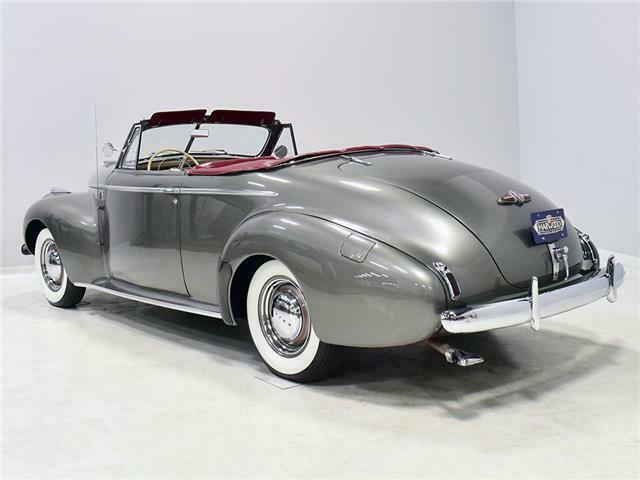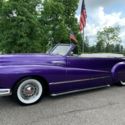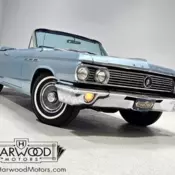1940 Buick Super 56C 66237 Miles Gray Convertible 248 cubic inch straight-8 Man
| Make: |
Buick |
| Model: |
Super 56C |
| Type: |
Convertible |
| Trim: |
-- |
| Year: |
1940 |
| Mileage: |
66237 |
| VIN: |
13849114 |
| Color: |
Gray |
| Engine: |
248 cubic inch straight-8 |
| Fuel: |
Gasoline |
| Transmission: |
Manual |
| Drive type: |
-- |
| Interior color: |
Red |
| Vehicle Title: |
Clean |
| Item location: |
Local pick-up only |
1940 Buick Super 56C -- Additional Info:
Buick introduced the Super line in 1940, presumable to bridge the gap between the entry-level Special and the bigger, more powerful Century and add to their bottom line. While 1940 was the best sales year to date for Buick, what really happened is instead of enhancing sales of the models around it, the Super stole sales from the Special AND Century. Wearing Roadmaster bodywork and upscale interiors, the Super was far more car than a Special for not a lot more cash, yet was still significantly less expensive than a Century. For a value-oriented customer who still wanted style, the Super was as good as it got. Total 1940 Super production was 129,527 which far outpaced everything else in the lineup including the Special. But despite these record-setting numbers, only 4804 Super Model 56C convertible coupes were built making them rather rare in the grand scheme of things. This lovely Yosemite Gray 56C was restored by the legendary Lewis Jenkins in the late 1990s and the quality of his workmanship is evident everywhere you look. As one of the biggest names in pre-war Buick restoration, a Jenkins car still carries a certain amount of prestige because you know it was done right, particularly inside, which was a Jenkins specialty. Code 547 Yosemite Gray is this car’s original color, and since automakers were just starting to experiment with metallic paints, it has a wonderful iridescent shine to it that looks entirely appropriate. It’s not a modern metallic, but it does glow in the sunlight. Fit and finish are excellent, with doors that fit flush and well-fitted stainless trim that hugs the body’s curves. There are very few signs of use or age, again indicative of the quality of the work and the car it has received in a prominent New England Buick collection. The Super benefitted from GM’s all-new “torpedo” bodies, which deleted running boards and gave a longer, lower profile with fenders that were tucked in a little tighter. Dressed in the lovely gray paint, this car looks sleek and elegant all out of proportion to its price. On any car of this period, the chrome trim can be especiall problematic to restore. Things like the grille, hood ornament, parking light housings, and side vents were all made of what we commonly call “pot metal.” In practice it was easy to cast and took plating easily, but in the long term it tended to corrode from within, developing pits that are notoriously difficult (read: expensive) to repair. Nevertheless, someone either found excellent original pieces and had them re-chromed or spent an astronomical amount of cash refinishing the brightwork on this Super, because it remains in first-class condition throughout. Bearing in mind that this restoration is now 30 years old, there’s only the slightest wear on the grille and other cast pieces and the stainless body accents shine up like chrome. Details are crisp and the custom cloisonné emblems front and rear remain bright. This Buick doesn’t resemble a cost-leader in any way and the restoration, even in 1998 dollars, probably cost at least twice the asking price. It’s just gorgeous. Code 855 means a red leather interior, and that’s what’s inside today. Lewis Jenkins specialized in Buick interiors, so it shouldn’t be a surprise that his work is beautifully done. Stitched in the original patterns, it shows only very slight use and the contrast with the charcoal gray paint is just gorgeous. However, as beautiful as the leather is, just look at that dashboard, which has some of the most convincing woodgraining we’ve ever seen plus ornately turned dash instrument panels that replicate the factory pattern exactly. Most of the plastic pieces were re-cast, including the steering wheel and gauge faces, although it appears that the piece around the ignition lock is original—unlikely that those are being reproduced. All the gauges work except the temperature gauge, but NOS replacements are readily available and installation is straightforward. We believe the radio was installed by the dealer given the location of the antenna on the side of the cowl instead of inside the front fender, and the Sonomatic AM radio does work properly. The black canvas top is power-actuated by a pair of vacuum cylinders, and it does work but is a bit sluggish, particularly going up, and it might just need some exercise. There’s also a matching burgundy boot that matches the interior. In back, the torpedo body style offers a larger trunk that was fully upholstered in correct burlap-like material and there’s a full-sized spare tucked underneath along with a jack assembly. The Super used the same 248 cubic inch OHV straight-8 engine as the Special, which was rated at 107 horsepower in 1940. In application, however, this car feels lively and energetic around town and cruises easily at 55 MPH without much drama at all. That all suggests someone did their homework in the mechanical department. It starts quickly and easily using the accelerator pedal starting system and settles into a smooth idle quickly without any drama. It’s also correctly detailed with corporate gray engine enamel, an oil bath air cleaner, a replacement cloth wiring harness, and proper hose clamps, decals, and other markings. It’s extremely quiet at idle and there’s a pleasing 8-cylinder burble out back on the road, but under all circumstances it’s polished and smooth as you’d expect. Speaking from experience, these are reliable, durable engines, parts are easy to get, and despite what you may hear about cruising speeds, this one seems to be eager to run. It’s just fantastic to drive. Underneath it’s just as detailed, with body-colored floors showcasing the satin black frame and suspension components. The rockers have been expertly reconstructed, as is common with the early GM torpedo bodies (the rockers are box-section steel that collected debris that stayed wet and rotted them from within), but the floors themselves are original. You’ll note the optional under-seat heater, 3-speed manual transmission with a torque tube driving the rear, which we believe has high-speed 3.90 gears inside. Even the splash pans around the engine are in place—good luck finding a set of those today! The suspension is appropriately luxurious and the manual drum brakes are plenty powerful for the car’s weight and performance. 16-inch steel wheels were painted to match the bodywork and treated to red pinstripes, as well as a set of 6.50-16 BFGoodrich wide whites. We know these cars extremely well—Harwood Motors owns two 1941 Buicks and recently sold a 1941 Super 56C convertible coupe very similar to this one. In comparison, this car is superior in almost every way. It’s beautiful, smooth, competent, and almost practical with a full-sized back seat. It’s the right size so that anyone can manage it and around town it’s quick and nimble. On the open road, it’s a pleasant cruiser, making it an ideal tour car. If you can’t tell, we really like this Buick a lot. Call today! Harwood Motors welcomes and encourages personal or professional inspections of any vehicle prior to purchase.























